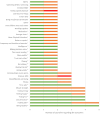Child opinions related to a core outcome set for school-based healthy lifestyle behavior interventions: the COCOS study
- PMID: 40308918
- PMCID: PMC12040649
- DOI: 10.3389/fpubh.2025.1519467
Child opinions related to a core outcome set for school-based healthy lifestyle behavior interventions: the COCOS study
Abstract
Introduction: Including children's perspectives developing health programs is a priority. This study gathered children's perspectives on outcomes in a Core Outcomes Set (COS), which they believe are important to measure in school-based healthy lifestyle behavioral interventions.
Methods: Children aged 8-12 years from six countries across three continents participated in standardized interactive focus groups. An animation video was used to explain all relevant concepts (e.g., "intervention", "outcomes") and showed animated children engaging in a variety of lifestyle behaviors at school. Participating children then brainstormed and proposed outcomes they consider important to measure when evaluating a school-based "healthy lifestyle programme". Next, children individually rated the importance of the outcomes using a traffic light system (red, "not important"; orange, "important"; green, "very important"). Similar outcomes (across focus groups and countries) were merged, and an overall importance rating was given to each outcome (across countries and overall). An outcome was considered important for inclusion in a COS if ≥70% of children scored the outcome as "very important" and <15% scored it as "not important".
Results: Children (n = 159) proposed 170 unique outcomes. Children proposed thirty-six outcomes in at least two countries, of which 20 outcomes received an overall rating of "very important" in all countries where the outcomes were reported. Of these 20, five outcomes were reported by children in at least four countries: being healthy, healthy diet, concentration, having fun, and feeling happy.
Conclusion: Children reported a wide range of outcomes related to physical and mental health, as well as enjoyment and social skills, such as having fun and making friends. All outcomes reported by children in at least two countries and considered "very important" will be considered for inclusion in the consensus stage of developing a COS for school-based intervention studies aimed at childhood overweight and obesity prevention.
Keywords: children's perspectives; importance ratings; international; obesity prevention; outcomes.
Copyright © 2025 Altenburg, de Vries, Barbeau, Button, Cox, Lannoy, MacDonald, Naidoo, Staiano, Tremblay and Harrington.
Conflict of interest statement
The authors declare that the research was conducted in the absence of any commercial or financial relationships that could be construed as a potential conflict of interest.
Figures


References
-
- Commission on Ending Childhood Obesity . Report of the Commission on Ending Childhood Obesity. Geneva: Commission on Ending Childhood Obesity; (2016).
-
- Ng M, Fleming T, Robinson M, Thomson B, Graetz N, Margono C, et al. . Global, regional, and national prevalence of overweight and obesity in children and adults during 1980-2013: a systematic analysis for the Global Burden of Disease Study 2013. Lancet. (2014) 384:766–81. 10.1016/S0140-6736(14)60460-8 - DOI - PMC - PubMed
-
- NCD Risk Factor Collaboration (NCD-RisC). Worldwide trends in body-mass index, underweight, overweight, and obesity from 1975 to 2016: a pooled analysis of 2416 population-based measurement studies in 128.9 million children, adolescents, and adults. Lancet. (2017) 390:2627–42. 10.1016/S0140-6736(17)32129-3 - DOI - PMC - PubMed
-
- Brown T, Summerbell C. Systematic review of school-based interventions that focus on changing dietary intake and physical activity levels to prevent childhood obesity: an update to the obesity guidance produced by the National Institute for Health and Clinical Excellence. Obes Rev. (2009) 10:110–41. 10.1111/j.1467-789X.2008.00515.x - DOI - PubMed
MeSH terms
LinkOut - more resources
Full Text Sources
Medical

